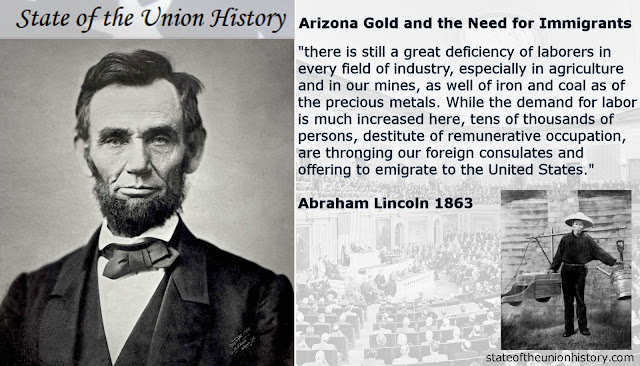1863 Abraham Lincoln - Arizona Gold and the Need for Immigration

In President Lincoln's last State of the Union Address, he urged Congress to look for ways to assist in the noble effort to help poverty stricken immigrants to come to the United States to work in our mines. This effort was spurred by recent reports of rich gold mines, veins of silver and inexhaustible mines of copper in the Southwest. It was an opportunity to help pay for the very costly war.
In 1862, New Mexico Governor Henry Connelly had learned of discoveries of gold in Arizona from prospectors who reported that they had been driven away from their claims by the Apache Indians. Connelly was intensely interested in the reports of gold strikes and wrote letters to the federal government for assistance in protecting these mines. On August 32, 1862 Connelly wrote to Secretary of State William Henry Seward that "very rich and extensive gold fields" had been discovered in Arizona and military forces were needed to hold back the hostile Indians. Connelly reported that the gold existed in an area about 400 miles southwest of Albuquerque in an entirely unpopulated country that "has been for ages the haunt of different bands of Apache Indians". Connelly suggested that unless a strong military force was stationed round the mining districts, many lives will be lost.
Just months later, General James Carleton who was marching his men from California to Arizona fighting the Navajo Indians along the way, returned to Santa Fe excited with news about discoveries of gold that "can be seen distinctly with the naked eye". By February of 1863, Carleton's men were engaged in duel enterprise of fighting Apache Indians and mining for Gold. Carleton established Fort West in the Pinos Altos country to protect miners and give his soldiers an opportunity to prospect and mine for gold. Carleton wrote a letter back to General Thomas in Washington describing evidences of "rich gold fields and of veins of silver and inexhaustible mines of the richest copper in the country". These reports of gold helped push through Congress the Organic Act which called for a division of the New Mexico territory, and on February 24, 1863 President Lincoln signed the act creating the Arizona territory. Congress and the president were greatly influenced by the need for precious metals to help pay for the war. Later in September of that year, General Carlton further encouraged the mining of these minerals by sending samples of pure gold from the area to the Secretary of the Treasury Salmon P. Chase for the president to behold. in that same year, 25 men signed a contract to establish the very first mining district in Central Arizona near present-day Prescott Arizona. The district was known as the Pioneer Mining District and began a flood of immigrants from the States that brought the population of non-Indians from 25 to over 1000 within just one year.
The opportunities seemed endless. The resistance of the Southwest Indian nations had been subdued and the abundance of minerals were just waiting to be mined. In President Lincoln's 1863 State of the Union, he submitted for consideration of congress a system to encourage immigration. The demand for labor was great, and "tens of thousands of persons, destitute of remunerative occupation, are thronging our foreign consulates and offering to emigrate to the United States". These were poverty stricken (destitute) foreigners looking for paid (remunerative) work. They just needed a way to get to the United States, and Lincoln felt it would be a noble effort for the federal government to assist them.
"The condition of the several organized Territories is generally satisfactory, although Indian disturbances in New Mexico have not been entirely suppressed. The mineral resources of Colorado, Nevada, Idaho, New Mexico, and Arizona are proving far richer than has been heretofore understood. I lay before you a communication on this subject from the governor of New Mexico. I again submit to your consideration the expediency of establishing a system for the encouragement of immigration. Although this source of national wealth and strength is again flowing with greater freedom than for several years before the insurrection occurred, there is still a great deficiency of laborers in every field of industry, especially in agriculture and in our mines, as well of iron and coal as of the precious metals. While the demand for labor is much increased here, tens of thousands of persons, destitute of remunerative occupation, are thronging our foreign consulates and offering to emigrate to the United States if essential, but very cheap, assistance can be afforded them. It is easy to see that under the sharp discipline of civil war the nation is beginning a new life. This noble effort demands the aid and ought to receive the attention and support of the Government."
This was only 19 years before the Chinese Exclusion Act was signed by President Chester A. Arthur prohibiting all immigration of Chinese laborers
References
Presidency.ucsb.edu. (2019). Third Annual Message | The American Presidency Project. [online] Available at: https://www.presidency.ucsb.edu/documents/third-annual-message-9 [Accessed 23 Feb. 2019].
Keleher, W. and Simmons, M. (n.d.). Turmoil in New Mexico, 1846-1868. pp.337-338.
McGinnis, R. and Smith, C. (1994). Abraham Lincoln and the western territories. Chicago: Nelson-Hall, pp.90-91.

